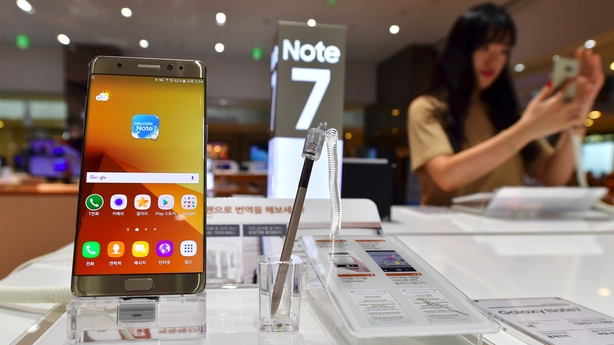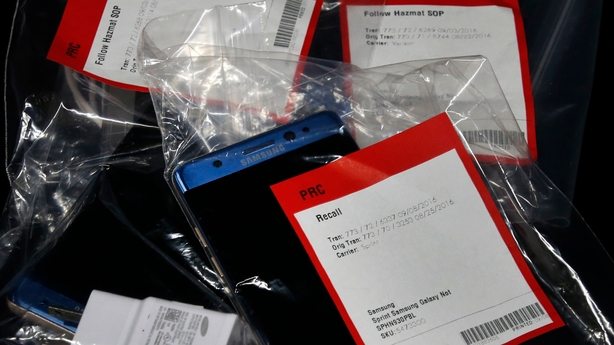It was supposed to be vying for the accolade of best smartphone ever.
And the early reviews suggested it might well have been.
But instead, two months after its glitzy launch, the Samsung Galaxy Note 7 looks set to go down as one of the costliest and most embarrassing product flunks in history.
Bad enough that the product was recalled and replaced once, because a small number were found to be at risk of spontaneously combusting.
A second halt in production, however, because the replacements didn't resolve the problem meant only one thing; the inevitable announcement of the end of the Galaxy Note 7.
A decision which instantaneously wiped $20 billion off Samsung's value.
The product was launched with usual fanfare in August.

The only problem at the start seemed to be supplying enough of the devices, such was the demand for what appeared to be a superb phablet.
But not long afterwards, reports began emerging of some of the devices catching fire out of the blue, and even exploding.
There were reports of minor burns and images and videos began appearing on social media of charred handsets.
Airlines took the unusual step of publicly requesting at check-in and at departure that passengers power down the units while on the aircraft.
Samsung, to its credit, was quick to halt production and begin investigations.
These led to the identification of an issue with a battery produced by one supplier and used in some, but not all, of the phones.
In an effort to limit the damage and salvage what it could, the company made the correct but costly $1 billion decision to recall the 2.5 million devices already on the market, and offered to replace them with safe versions of the Note 7, or give a refund.

The Samsung corporate and supply chain machine swung quickly into action, and the replacement programme seemed to be progressing well.
But it was all predicated on one fundamental assumption - that the battery problem was actually the cause of the fires, and that it had been fixed.
An assumption which was to prove incorrect.
And so, in the past few days more of those frightening images and videos started to emerge again on social media.
This time, however, the charred remains in the pictures were of the replacement Samsung Galaxy Note 7s.
A development which left the company with really only one viable option - to mothball the device permanently.
Sure, it could have embarked on a further effort to identify and rectify the source of the problem.
Offers of compensation could have been made to Note 7 owners, and overtures made to authorities to convince them of the device's safety.
But in reality irreparable damage had already been done to the device's image, the Note brand and to Samsung's name.
Sometimes it is better to give up and move on, even if by doing so it is going to cost you an estimated $17 billion to do it.
Because an ongoing saga, played out in public, accompanied by safety concerns, and all amid shareholder pressure, would have proven even more costly for the giant company.
It's not clear how many of the devices are in circulation in Ireland.
But it looks that because the first recall happened around the time the pre-orders were starting to be delivered here, the numbers are low - probably in the hundreds.

Operators have now begun the process of offering those Note 7 owners options including an alternative phone, a refund and a rolling back of their contract to a pre-upgrade position.
Meanwhile in South Korea, many questions will now correctly be asked about how this could have happened.
The answers are likely to centre on the inherent pressure and competition at the top of the smartphone market, which may have led to corners being cut.
Mobile manufacturers are increasingly under pressure to fit more and more features into a smaller space.
And while modern electronic engineering is exceptionally advanced and clever, the integrated nature of these components in these devices means one small failure can have catastrophic consequences for the whole handset.
Plus, phone manufacturers work in very clearly defined cycles of design, manufacturing and distribution.
Anything that upsets that cycle is likely to cost millions, so the pressure to complete on time is immense.
No doubt other big manufacturers such as Apple and Sony, and emerging Chinese manufacturers like Huawei and Oppo, have already drawn up plans to capitalise on the misfortune of their competitor.
Samsung had, after all, been depending on the Note 7 to bolster its earnings during the quarters prior to the launch of the next iteration of the current smaller Galaxy S7 and S7 Edge.
But those competitors would all do well to pause for a moment to step back and consider how there but for the grace of God, and a hastily designed component, they all go too.
Comments welcome via Twitter to @willgoodbody







